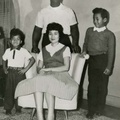The U.S. military occupation of Japan following World War II resulted in the largest cohort of Japanese immigration of Japanese to the U.S. since the 1924 Immigration Act. This migration of Japanese women married to U.S. soldiers drastically changed the make up and complexion of the Japanese American community as these immigrant interracial American and Japanese families brought with them multiracial Japanese/Japanese American children.
What does it mean to be Japanese? To be Black? To be both, at the same time. To be sure the world sees me as Black—I’d say African American but that would be too polite because the ways in which I am treated, looked at, questioned, and feared says Black (this might well be the subject of another column). Yet, inside where my mind reasons, where my mind feels, sees and hears I am Japanese and Black. To separate them is nearly impossible, at least for those of my generation—I was born in Japan in 1957 the second son and youngest child but, primarily reared in the U.S. Indeed, I was raised throughout the U.S., having called Kansas, North Carolina and Texas home as child. As an adolescent I spent my formative years on Okinawa. As an adult, New Hampshire, Pennsylvania, Connecticut, Alaska, and California (northern & southern) have occupied my return address.
As a cultural anthropologist I can argue gracefully how the two cultures of my parents were differences in kind with differing emphases, but as a person such abstract notions fall hollow--for while the two cultures may indeed be vastly different in mannerisms and expression, growing up in my family they were the same in context. For instance, both my Japanese mother (from Yokohama, Japan) and my African American father (from Wilmington, NC) emphasized the primacy of family, respect of elders and adults, obedience to parents, birth roles and duty to the family. They also drilled home hard work, education, team spirit, and the valuing of others before ones’ self. And, above all they valued “doing what is right” because it is right.
My parents taught me that as a younger brother I should honor and obey my older brother. I took this teaching seriously. So seriously in fact, I remember one event, when I was about 4 years old, in which I allowed my brother to place a hangman’s noose around my neck as we re-enacted a scene from a western movie we had seen on the T.V. the night before. I trusted my brother and after all, he would not really hurt me because I knew he had been taught to protect and care for me. Needless to say I was taught another lesson by this episode. Obedience is great, but don’t be “stupid.” As my father said, “It’s okay to think.” (I think my father imparted a pointed lesson on my brother as well, but you’ll have to ask him about that.) Despite this traumatic happening my brother and I flourished in our family roles. To this day he is still my champion. I can never ever repay him the untold hours of baseball and football catch he played to make me what would become an intercollegiate college football player. Nor, can I repay him for his forceful rebukes when I messed up or disrespected my mom. Even today he is my “onichan” on whom I know that if all else fails, he IS there.
But our teachings did not end there. We were taught “hard work” and full effort. I can remember a time in college. In my freshman winter term I nearly flunked out of college. When I brought my grades home to my mom, she merely said, “The sun will come up tomorrow.” Throughout that term I had told my mom how hard it was, and how hard I was working. I was frustrated and afraid. After all, poor grades were always what “other people received.” Her words when the “F” appeared on the report card surprised me. I thought she’d be mad, disappointed and embarrassed. Her words told me a whole host of things, including “she loved me” without actually saying them. By my senior year my grades had turned around and I brought home a “good report card.” She left it on the dining room table. During that break a friend of mine was at the house and upon seeing the report card said to my mom, “I bet you’re proud of Curtiss.” She merely replied, “It’s about time.” My friend was taken aback. But, I was not. Again, she had said, “she loved me” and was proud of me. After all, if not, she would have hidden that report card somewhere among the scores of empty tofu cartons and Styrofoam meat trays. I knew that I had brought her honor.
My African American father, too, emphasized effort and commitment. When I first began playing organized football my father was my head coach. The irony was that on the field he was not my father he was my coach. Yet, to me he was also my father in that I knew that my actions reflected upon him. If I did not give my full effort, I reasoned, then why would any of the other players on the team give their full effort. Every play at practice or during the games commanded my full attention, every block my total effort and I knew I needed to be at the lead of every wind sprint. Every success reflected his effort. This notion of commitment to the coach beyond the “game” continued to drive me throughout my athletic career. Indeed I remember thinking in college that my performance on the field could impact my coach’s employment and his ability to care for his family—Coach Kopp had four children and a wife whose smile still warms my memories. In concert with my father’s teaching were my mother’s admonitions of “don’t embarrass the family” and “don’t show off.” Or in other words work hard, attend to business and remember you are a part of something larger than yourself—in this case a team. (I guess this was the Japanese version of there is no “i” in team.) Together my parents’ teachings provided me with the mental foundation for athletic and academic success.
My parents continually taught me that I was a part of something larger than myself, be it my family, ethnic group or team. They trained me to recognize and respond to the needs of others and to take into account what other people think, without letting it “totally” control me. In that sense, they also taught me to be myself, albeit within situational constraints because my actions would NEVER represent just me, but would reflect upon family, race/ethnic group and my associations.
When I look at how the two cultures of my parents came together in our household I never reasoned the two as conflicting. Within African American cultural tradition, my father taught me the value of my mother. She was to be respected, obeyed, honored and protected. Within Japanese cultural tradition my immigrant mother taught me to value my father. He was to be respected, obeyed, honored and protected. My father taught me through stories and words. My mother taught me through actions and few words. In this way, the two cultures complimented each other.
Yet, there were differences.
Communicating with my parents required remembering to whom you were talking to. My father demanded eye contact, while my mother required eyes directed downward--particularly when I was in trouble. Trust me by the age of 5 I knew the difference, especially because I got so much practice. And when they called me out together, my head bobbed up and down—not unlike those little dogs in the back of a car window or the bobble head dolls given out at athletic events these day--as I attempted to quickly respond to whomever was talking.
And, there was also creation.
Perhaps the most fun mixture of culture came at the kitchen table. Gohan with every meal, turnip or mustard greens cooked slowly on Sunday afternoon, sweet potato pie at holidays, octopus or squid to freak out my Midwestern high school friends, and of course teriyaki chitlins made our family cuisine our own.
As I think about this topic I am a bit more reflective because my mother lost her fight to lung cancer in 2001 and my father died in 1975. I miss them both dearly. Despite having talked and written about “hapa issues” for some 25 years now, thinking about how I have come to be who I am continues to be interesting for me. What part is Japanese? What part is Black? I love the spontaneity of African American culture. The joy of a loud belly laugh has embarrassed my Sansei wife and daughter more than once in public settings—though I think they are both used to it now. I love everyday directness of Japanese and Japanese American culture. I mean where else can you speak of a bowel movement in the same breath as what’s for dinner. I value the African American ability to be “in your face” when my family and friends are at stake. I respect the Japanese American quiet reserve where words are not needed to communicate even the deepest emotions and, where conflict can be resolved through indirect actions. I love back beat of Johnny Mori’s Taiko solos, teriyaki flavored fried chicken at church potlucks and friends whom my daughter calls auntie and uncle. So, I am left with the questions of what does it mean to be? But you know what...the most fun is the continual discovery of the answers.
© 2007 Curtiss Takada Rooks




